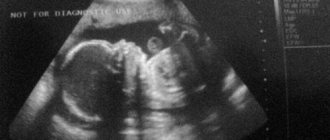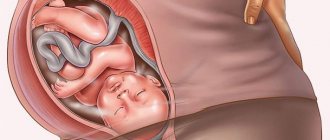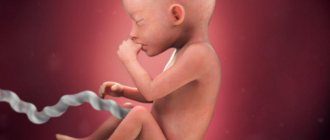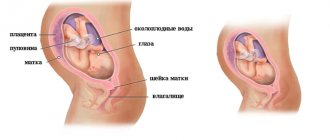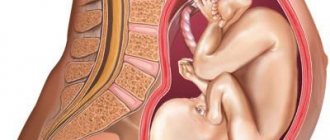07/31/2018 Category: Pregnancy calendarAuthor: Lyudmila
More than half of the pregnancy is already over. The second trimester is considered a good time for the expectant mother - the symptoms of toxicosis have already disappeared, and the tummy has not yet grown enough to cause serious inconvenience.
- Visit to the
ultrasound
- Discharge
- Preeclampsia
- Sex
Fetal size and development at 21 weeks of gestation
At the twenty-first week, the baby has already reached an impressive size. He looks like a small doll . Its length is about 28 cm and its weight is approximately 400 grams. All organs are formed, and the skin has become less transparent and thin.
When pregnant with twins at 21 weeks of pregnancy, babies weigh a little less - about 370 grams, and the length is in no way inferior to “singles”.
How does the fetus change at this stage?
- adipose tissue increases;
- thermoregulation improves;
- the formation of eyebrows and eyelashes is completed;
- the rudiments of baby teeth appear;
- endocrine glands perform their functions;
- the spleen begins its work;
- the nervous system is improved;
- the brain develops rapidly;
- the intestine develops. This is facilitated by amniotic fluid swallowed by the fetus;
- the nervous system is strengthened;
- taste buds develop. A child can distinguish sweet from bitter;
- the immune system is improving. White blood cells appear in the blood to help fight infections;
Behavior. 21 weeks is a new stage in the development of the child’s motor system. The fetus makes not only chaotic movements. He learns to control them. The child alternates between phases of activity (about 10-15 per day) and phases of sleep.
The number of movements has increased significantly, reaching up to 200 times a day. But mom feels less than half of them. At 21 weeks, the baby is able to hiccup in the womb. It feels like frequent rhythmic contractions.
Changes in a woman's body
At week 20, changes in a woman’s body are already noticeable to her and those around her, but do not yet bring discomfort and do not disrupt their usual way of life. The tummy is rounded, the navel protrudes. People around her now understand that the woman is in an interesting position; it is difficult to hide the fact of pregnancy. A small belly does not prevent you from moving freely, but it’s time to think about special clothing for the comfort of the expectant mother and child.
The fundus of the uterus is at the level of the navel. Every day its walls become thicker, it grows along with the fetus. From this time on, the uterus will increase by 1 cm every week of the child's intrauterine development. However, the size of the organ does not cause discomfort, does not put pressure on the diaphragm and does not lead to heaviness in the abdomen.
This is a pleasant time when a woman feels a baby inside her, but can lead her usual lifestyle.
Colostrum begins to be released from the nipples of the mammary glands - a precursor to breast milk, which is so important for the health of the child after birth. Colostrum is produced in small quantities until the moment of birth. It is necessary to dry the discharge with cotton swabs in time to prevent maceration and inflammation of the nipples.
There is abundant clear mucous discharge from the vagina - this is normal. Streaks of blood appear when cervical erosion worsens or after careless sex. If you maintain intimate hygiene, the admixture of blood in the discharge will stop within a few days.
The rapidly growing uterus causes stretching of the skin on the abdomen. By week 20, a woman can gain 4-6 kg. These processes contribute to the formation of stretch marks on the body of the expectant mother. Timely use of special gels or creams helps prevent unwanted consequences.
By the 20th week, the general health of a woman with a normal pregnancy is not satisfactory. Appetite improves, stool is normal, mood is good. The increase in the total amount of blood due to the formation of several circles of blood circulation occurs due to the plasma part. This can lead to a decrease in the physiological parameters of red blood cells and hemoglobin - a mild degree of anemia.
The placenta in the 2nd trimester of pregnancy is well formed and performs a barrier function. This allows you to expand the mother’s diet and the list of acceptable medications. At this time, placenta previa can be diagnosed, which requires special monitoring by an obstetrician-gynecologist and preparation for delivery by cesarean section.
What happens to mom at 21 weeks
Appearance, belly size and weight gain
Starting from 21 weeks, a woman's weight will increase rapidly. This is caused by both the rapidly growing fetus and increased appetite. A woman may develop strange taste preferences. A weight gain of about 3.5-4.5 kg is considered normal . Above you can see photos of mothers' bellies at 21 weeks of pregnancy.
The uterus continues to grow and rise. Now its upper edge is 1.25 cm above the navel. Hiding the appearance of a belly no longer makes sense - it is simply impossible. It is strongly rounded and becomes clearly visible.
Hair and nails are growing by leaps and bounds, there is increased sweating, stretch marks appear, and the breasts have greatly enlarged.
Sensations, movements, pains in mother
At week 21, a woman experiences not only unpleasant sensations from pregnancy, but also a lot of positive emotions from the movements of her baby. The baby's somersaults in the stomach do not yet cause painful sensations, but they are felt quite clearly and distinctly.
Colostrum begins to be released from the breast. A substance that a newborn will eat for the first 2-3 days before milk comes in.
Unpleasant moments can be different for everyone:
- Now the child begins to gain weight every week. Because of this, the mother’s appetite greatly increases. Since the weight has increased greatly, my back begins to hurt . Often at 21 weeks a runny nose appears.
- An enlarged belly causes sleep problems . You can’t sleep on your stomach and back, and on your side it becomes uncomfortable. Frequent urination also aggravates this problem. When a woman lies down, heartburn appears.
- Constipation will not disappear during this period either. Because of this, you have to watch your diet and avoid eating foods that strengthen your stool.
- Often, the enlarged uterus puts pressure on the blood vessels, causing swelling of the legs and varicose veins. Shortness of breath may appear, because the lungs are also a little constrained now.
- At this time, the stomach may begin to pull . This can be caused by various reasons. This includes tension in the uterine ligaments, expansion of the pelvis, constipation, and, much less harmless, the threat of miscarriage.
- Due to a decrease in blood pressure, dizziness and weakness . Problems with gums also often occur. They begin to hurt and bleed.
Training contractions called Breston-Hicks contractions may now appear. They are not painful and do not harm either the mother or the child.
If acute cramping pain appears, radiating to the lower back, sometimes accompanied by vomiting and bleeding, then there is a direct threat of miscarriage. It is necessary to urgently consult a doctor. After all, even if it is not possible to maintain the pregnancy, doctors will be able to save the child’s life with appropriate care.
Possible allocations
The discharge at week 21 should not differ from the discharge that was previously (milky in color, uniform in consistency, with a not pronounced odor).
But other discharge may appear that requires consultation with a doctor:
- thin , watery discharge may indicate premature rupture of amniotic fluid;
- curdled white or greenish discharge accompanied by itching indicates thrush;
- the cause of the appearance of a sharp unpleasant odor of discharge may be sexually transmitted infections;
- discharge mixed with blood. Characteristic of placenta previa or abruption. This is a critical condition that requires immediate specialist intervention. If the bleeding is minor, doctors will prolong the pregnancy with special medications. If this is not possible, then the best way out of the situation is childbirth. A baby born at 21 weeks can be saved.
Psychological condition
At week 21, the mother’s psychological state is more or less stabilized. In general, the woman is in harmony . The hormonal boom is a thing of the past, the body has adapted, and she likes her own body.
At this time, women try to establish emotional intimacy with their child. They start reading books to him, talking to him, trying to feel his reactions.
A little overshadowed by the state of constant fatigue due to lack of sleep, heartburn, back pain and other unpleasant companions of this week.
Determining the deadline
The starting point of pregnancy for doctors is the day of the last menstruation before conception.
You have crossed the “equator” - half of the gestation period is in the past. You already know that doctors count the pregnancy period using the obstetric method - from the day of the last menstruation before the fertilization of the egg. In 1 obstetric month there are exactly 4 weeks of 7 days. The actual (embryonic) gestation period of a baby is usually less than the obstetric period by a couple of weeks.
So, the 21st obstetric week of pregnancy corresponds to:
- sixth month of pregnancy;
- second trimester;
- 19 weeks from conception;
- 17 weeks from the date of missed menstruation.
Tests, examinations and ultrasound at the 21st week of pregnancy
At 21 weeks, a woman will have to visit several doctors in addition to her obstetrician-gynecologist. You will have to go to an appointment with an otolaryngologist, dentist, therapist and ophthalmologist. Each of them will write down their verdicts on a special sheet issued at the antenatal clinic.
Before visiting an obstetrician, you will need to undergo standard urine and blood tests , a blood test for hormones if indicated, and also an electrocardiogram.
At an appointment with a gynecologist, the doctor will perform the following manipulations:
- pressure measurement;
- weighing;
- listening to the fetal heartbeat;
- measuring the height of the uterine fundus.
The second ultrasound screening is usually done at 20-24 weeks. So, if you haven't had your screening exam done in the previous week, now is a good time to do it. During the procedure, the doctor must make sure that there is no tone of the uterus or congenital malformations of the baby, because only up to 24 weeks is it possible to terminate a pregnancy for medical reasons.
are recorded in the ultrasound results :
- measuring brain structures;
- length of the child's long bones;
- checking the structure of the hands and feet;
- checking the structure of the liver;
- checking the presence of the stomach and bladder;
- study of the condition of the kidneys and intestines.
We invite you to watch a video of an ultrasound of the fetus at 21 weeks of pregnancy, and also look at the photo of the child above.
Possible deviations from the norm
Any deviations from the norm should prompt additional research. If fetal developmental disorders are detected by ultrasound, additional consultation with specialists is necessary. They will help diagnose developmental disorders of the child that are compatible and incompatible with life.
As a result of visiting the doctors listed above, a conclusion will be made whether the woman can give birth on her own or whether a caesarean section . A planned caesarean section is prescribed if spontaneous childbirth would harm the woman’s health.
When you need a doctor's help
Tell your doctor about any problems with your health at your appointment.
The second trimester is considered a good time for mother and baby. During this period, various complications of pregnancy are detected less often than in the first and third trimesters. However, there are dangers, if signs of which appear, the mother should consult a doctor.
Preeclampsia
High blood pressure can be a symptom of gestosis.
This phenomenon is called late toxicosis. For the first time, symptoms of gestosis may appear after the 20th week of pregnancy. According to statistics, the diagnosis is most often made in first-time mothers, during pregnancy with twins, in the presence of chronic kidney disease, or genetic predisposition. Symptoms of gestosis are:
- internal or external swelling;
- the appearance of protein in urine tests;
- high blood pressure.
Typically, the diagnosis of gestosis is made when all three signs are present simultaneously. If there is no swelling, but there is protein in the urine and high blood pressure, this condition is called preeclampsia. In especially severe cases, in the absence of adequate therapy, eclampsia occurs - seizures and stroke (cerebral hemorrhage).
Swelling is a common occurrence during pregnancy. If they are not combined with high blood pressure and the presence of protein in the urine, and are moderate, then treatment can be outpatient, using herbal medicine and diet. The presence of protein in the urine may be a sign of pyelonephritis, an inflammation of the kidneys.
Scientists cannot establish the exact reasons for the development of gestosis, but it is believed that the main “provocateur” is the placenta. Taking care of the baby’s blood supply, this organ activates mechanisms for raising blood pressure by constricting the blood vessels of the mother’s body. As a result, the blood supply to the kidneys and brain is disrupted, the blood becomes thicker, and the risk of thrombosis increases.
Preeclampsia is dangerous not only for the mother, but also for the fetus. This condition can cause growth and development delays in the baby due to blood flow problems. At later stages, gestosis provokes hypoxia (oxygen starvation) of the fetus. It is believed that the earlier signs of gestosis appeared, the higher the likelihood of the situation worsening in the later stages.
Therapy for gestosis involves a complex effect on its symptoms:
- taking sedatives (motherwort, valerian);
- lowering blood pressure with medications (Papaverine, Dopegit, Dibazol, magnesia);
- elimination of edema (diet, intake of herbal teas);
- stimulation of blood flow in the placenta (Curantil, Trental);
- normalization of water and mineral balance in the body (water-salt droppers in the hospital).
To prevent gestosis, experts advise minimizing the likelihood of stressful situations, taking herbal sedatives, and walking in the fresh air more often. Follow a sleep and rest schedule, sleep at least 8–10 hours a day. The diet should contain a sufficient amount of protein (meat, fish, eggs, dairy products).
To eliminate edema during gestosis, you should not take diuretic medications - this can lead to even greater thickening of the blood. It is better to minimize salty foods on the menu. It is permissible to consume 5–8 g of salt per day. The use of light herbal remedies to gently cleanse tissues of accumulated fluid is possible only on the recommendation of a doctor.
Risk of miscarriage
The threat of miscarriage can be determined by ultrasound if problems with the uterus, cervix, or amniotic sac are detected.
Up to 22 weeks of pregnancy, the process of premature birth of a fetus is called a miscarriage. After 22 weeks, the term is used - premature birth. According to statistics, most miscarriages occur in the first trimester of pregnancy. At this stage, a late miscarriage can only occur for serious reasons:
- infection;
- pathologies of fetal development;
- abdominal injuries;
- hypertonicity of the uterus;
- low presentation or early maturation of the placenta;
- short cervix and others.
If a miscarriage has already occurred, it is unlikely that it will be possible to save the baby, although such cases are known in medical practice. But if the miscarriage does not occur quickly, the pregnancy can be saved. See your doctor immediately if symptoms of miscarriage appear:
- the appearance of blood in vaginal discharge;
- sensation of contractions (sharp paroxysmal pain in the abdomen and back).
To prevent a miscarriage, the mother is placed in a hospital. She is prescribed bed rest, antispasmodic drugs, progesterone, and other drugs.
Frozen pregnancy
The absence of movements may be a sign of a frozen pregnancy.
This term characterizes the death of the fetus in the womb. The reasons for this may be the same factors as for a miscarriage, but the fetus does not pass through the birth canal; it remains in the uterine cavity. The risk of frozen pregnancy is especially increased in the first trimester, but is not excluded at this stage of gestation.
A frozen pregnancy is dangerous to the health of the reproductive system and even the life of the woman herself. If the dead fetus was in the womb for several weeks, intoxication of the body occurs. A frozen pregnancy does not manifest itself with specific symptoms; fetal death can be suspected in the following cases:
- the doctor is unable to listen to the fetal heartbeat;
- there are no movements in the abdomen during the day;
- there is pain in the lower abdomen;
- The color and smell of vaginal discharge changes (bloody, brown, green and unpleasant odor).
When a frozen fetus remains in the uterus for a long time, the woman experiences signs of intoxication: her body temperature rises, she feels nauseous, shivering, and feels weak and dizzy.
To confirm the diagnosis, an ultrasound is performed urgently. When a frozen pregnancy is definitely established, doctors induce artificial labor or perform surgical cleansing of the uterus. Subsequently, doctors are trying to find out the reason for this fatal outcome of pregnancy. A woman’s further reproductive function may be limited or preserved in full. In any case, the patient is observed by a gynecologist, and it is recommended to plan the next pregnancy no earlier than a year after the previous one.
Mom's diet, skin care and exercise at 21 weeks
A woman’s diet at 21 weeks, as well as throughout pregnancy, should be as healthy and balanced as possible .
Excessive consumption of salt and sugar should be avoided After all, salt promotes fluid retention in the body, which causes swelling, and sugar causes a lot of weight gain.
A woman should eat fruits and vegetables , which contain many vitamins and minerals that are so necessary during pregnancy.
To avoid heartburn, it is better to eat more often, but in small portions. And to prevent constipation, do not eat foods that strengthen the stool. Meat and fish must be present in the diet. Herbal tea is also beneficial for a pregnant woman.
Stretch marks often appear at 21 weeks . If they have already appeared, then you won’t be able to do anything special with them. The use of special creams for stretch marks that have already appeared rarely helps. You should have started taking care of your skin and moisturizing it much earlier.
Among the physical exercises at this time, it is necessary to perform Kegel exercises, which help strengthen the muscles of the pelvis and vagina.
During this time, you can swim in the pool and do yoga for pregnant women. It is also necessary to perform breathing exercises and take more walks in the fresh air.
Nutrition
Nutrition for a pregnant woman at 21 weeks
Proper nutrition is one of the conditions for a favorable pregnancy. At week 21, a woman is recommended to:
- eat often and in small portions. It is optimal to eat 5-6 times a day, avoiding mixing several dishes at a time;
- Eat foods high in calcium every day: cottage cheese, cheese, almonds, bananas;
- eat a lot of vegetables and fruits, raw, stewed or boiled;
- eat at least 400 g of meat daily;
- replace baked goods and sweets with dried fruits;
- eat cereal porridge (buckwheat, brown rice, oatmeal, etc.);
- dilute the juice with ½ water;
- observe the drinking regime. Unless otherwise prescribed by your doctor, drink about 2.5 liters of fluid per day;
- exclude harmful foods (fast food, smoked meats, pickles, raw fish);
- reduce the amount of salt consumed to a minimum;
- Avoid highly seasoned foods.
Following these simple rules will reduce the intensity of unwanted manifestations or get rid of them completely.
Vitamins
Taking vitamin complexes during pregnancy is often prescribed by a gynecologist. A woman should pay close attention to the prescribed dosage. It is not recommended to prescribe dietary supplements on your own without consulting a doctor. It’s good if vitamin complexes are an addition to the basic diet. It should be remembered that an excessive amount of vitamins is no less dangerous than a deficiency.
Sexual relations at 21 weeks
If there is no threat of termination of pregnancy, then sex at 21 weeks is not contraindicated . An enlarged belly will greatly complicate this process. But partners' search for other, more comfortable positions will solve this problem. It is necessary to choose only those poses in which pressure on the abdomen will be completely eliminated.
Sex has a positive effect not only on the mood of mom and dad, but also on the mood of the child, thanks to the production of the happiness hormone in the mother. And her increased libido and lack of need for protection will fill your sexual relationships with new colors.
What is needed to go on maternity leave, exchange card
A woman is sent on maternity leave at the moment when the pregnancy crosses its 30-week mark. But you should learn how to prepare for going on vacation now.
You will need:
- sick leave;
- certificate of early registration;
- application for leave.
Since registration of maternity leave takes some time, it is worth doing this now.
How to prepare for maternity leave:
- Obtain a certificate from your gynecologist confirming the duration of your pregnancy.
- Take a certificate of registration in the early stages of pregnancy. You will need it to apply for benefits.
- Make sure you get all the stamps.
- Provide the antenatal clinic with the documents necessary for registration. sick leave: certificate from a gynecologist, passport, insurance policy, pension certificate.
- Provide sick leave to work with your vacation application.
The exchange card contains all the necessary information about the pregnant woman: information about the mother, gestational age, test results, expected date of birth and other important data. It is necessary so that any doctor attending childbirth can navigate the situation even with premature birth.
Starting from week 21, it is best to always carry the exchange card with you. The exchange card must bear the signature of your gynecologist and the head of the antenatal clinic.
Recommendations for the expectant mother
To make pregnancy easier, mothers should follow some recommendations:
- to avoid the appearance of varicose veins, wear shoes with stable low heels, often lie with your legs elevated;
- watch your diet;
- listen to the baby's movements. There should be about 4 of them per hour;
- wear comfortable clothes and cotton underwear;
- exercise;
- do a back massage;
- do Kegel exercises;
- Avoid fried foods that cause heartburn. Eat often, but in small portions;
- always carry an exchange card with you;
- start processing maternity leave.
Video about 21 weeks of pregnancy
We invite you to watch the video, where they will talk about when an exchange card is issued and what data should be recorded on it. You will also learn about your rights during maternity leave , how you can apply for it, what benefits you should be paid and for how long. And also about how the law protects a new mother from divorce from her husband.
How is your 21st week going? How does your baby's kicks feel in your stomach? I hope that no deviations from the norm bother you, and that the ultrasound went great. By the way, did you take your husband for examination? What is his reaction? Share your experience with us !
We recommend reading:
- 3rd week of pregnancy: what happens to the baby and mother 4th week of pregnancy: what happens to the baby and mother 14th week of pregnancy: what happens to the baby and mother What happens to the baby and mother at 26 weeks of pregnancy.

